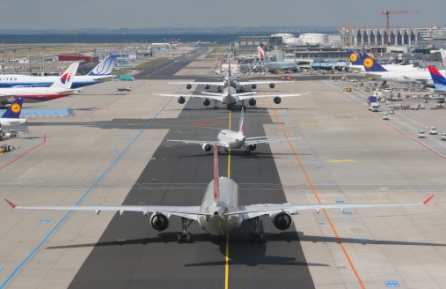European airport leaders met in Milan for the recent ACI Europe annual general meeting in far better spirits than the previous year, but the mood remains of a sector digging in for continued tough conditions in the short-term. Traffic levels, excluding the exceptional recent air cloud airspace disruption which shut down many European airports, have improved from the sharp declines seen at the height of the economic crisis. But the troubled pace of the European economic recovery seems likely to take its toll on airport traffic levels for the year as a whole.
 |
|---|
| Frankfurt Airport was back on the growth track in May, passenger levels jumping 7% to a new record for the month |
This reflects concerns about low consumer confidence and its impact on travel as governments attempt austerity measures not seen for generations in order to turn round national finances. This uncertainty has already prompted IATA to predict European carriers will be the only region still in the red this year. But it also reflects an anticipated lag, inherent in the respective airline and airport business models, between the recovery of the two parts of the business. Airlines are exercising far stricter capacity discipline in a bid to claw back yields which have plummeted over the last year. While this will help improve an airline's bottom line, it offers little respite for volume-based business that is airports as traffic levels will return at a much slower pace.
 |
|---|
"Some are seeing quite a strong recovery, while for others it is only small, or there is none at all."Olivier Jankovec, director general ACI Europe |
Passenger numbers across European airports was running more than 5% above 2009 levels over the first three months of this year, and freight traffic was up more than a fifth. But the traffic hit caused by April and May's sporadic closure of portions of European airspace due to the volcanic ash cloud derailed this progress. ACI Europe estimates European airports lost 17 million passengers and around €300 million as a result of the closure.
This hit, together with Europe's continued economic woes, means ACI Europe is predicting just a 3% increase in passenger traffic across its airports this year. This compares with IATA's estimate for industry-wide traffic growth of 7%. The growth predicted by ACI Europe would still leave European airports below 2007 passenger levels come year end.
Jankovec points to a mixed picture among European airports. "Some are seeing quite a strong recovery, while for others it is only small or there is none at all. The situation is very diverse," he says. "Some regions are performing much better. There is a more dynamic recovery in eastern Europe than in the western part."
While the major European airport hubs lost traffic in 2009, they are better positioned this year because of their lower dependence on European traffic and their ability to tap into booming Asian demand. "I think we will see the big hubs helped by the strong inter-continental growth," says Jankovec. "On the regional airports, some will suffer. We will see increased competition among airports in attracting traffic." He expects this will continue to push airlines into the driving seat in negotiations with airports. Strong growth from low-cost carriers has fueled much of the growth among European regional airports, but budget carriers themselves have pulled back their rates of traffic growth. "Now we are going to see lower growth of the low-cost traffic and that will impact on regional airports," he says.
In the mid-term Jankovec believes another impact of the debt crisis in European might be more airport privatisations and secondary sales. "If European states are going to look to raise money to cut the deficits, we are thinking the airports might be a good way to do that," he says. "We might see some secondary sales, because investors might not be getting what they [initially] thought they would be."
But the mid to long-term prognosis remains strong, and Jankovec believes will be stronger still if the European Commission presses ahead with liberalisation efforts - in particularly enlarging the European aviation market to include neighbouring states. "There is still growth potential if market access is liberalised. Low-cost carriers have shown they are willing to go into markets beyond the two-hour flight mark," he says. "That's why we are pushing [the EC] to accelerate its liberalisation drive, not only with the USA and Brazil, but primarily with the EU neighbouring countries."
Source: Airline Business
















